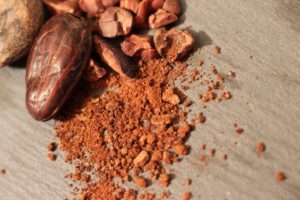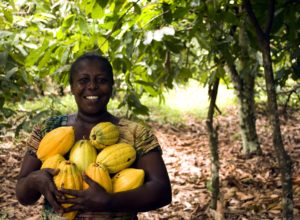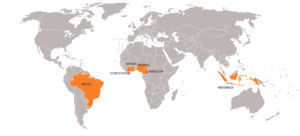Chocolate often conjures up images of happy children and sweet treats. While there are many things to love about chocolate, unfortunately the cocoa industry is also linked to forced labor and sustainability issues. Today, more people are concerned about where their food comes from and want to ensure their purchases—such as chocolate—are responsibly sourced. To properly address the cocoa supply chain, we first must be willing to look at these difficult topics in-depth.
Where does chocolate come from?
Chocolate is made from the seeds of the cacao tree. Cacao tree seeds are fermented, dried, cleaned, and roasted to produce cacao nibs. These cacao nibs are then further processed and liquefied to create what is called “chocolate liquor,” made up of cocoa solids and cocoa butter. Chocolate as we commonly known it is made up of varying proportions of cocoa solids and cocoa butter, with the addition of sugar and sometimes milk.
The use of cacao historically began in Mesoamerica, with evidence of beverages made from cacao dating back to 1900 BC. Today, of course, cocoa is used all over the world. While cacao is native to tropical regions of the Americas, from Mexico down to the Amazon basin region of South America, 60%-70% of its production today occurs in West Africa (Côte d’Ivoire, Ghana, Cameroon, and Nigeria), as well as Indonesia and Brazil.
Reliance on child labor
The cocoa supply chain has close links to child labor. Despite high demand for chocolate globally, small cocoa farmers in West African countries such as Côte d’Ivoire and Ghana often receive very low pay for their product. The pressure to harvest very large quantities of cocoa to meet high demand, combined with a lack of means to make necessary changes (such as hiring adult workers to increase harvest), has led to the use of child labor. In addition to poverty, other reasons for child labor in the cocoa industry are limited access to education in West Africa and lack of effective regulatory enforcement.
According to a 2015 report “Survey Research on Child Labor in West African Cocoa Growing Areas” by Tulane University, 2.12 million children were working in child labor in cocoa production and 2.03 million children were working in hazardous work in cocoa production in Côte d’Ivoire and Ghana combined. Tasks performed by children include land clearing, harvesting with dangerous tools, weeding, and carting heavy loads of fermented beans. Due to the amount of work required, children often either work excessive hours on school days, or do not receive an education at all.
Dwindling cocoa supply
 Cocoa sustainability is also an area of concern. High demand for and low supply of cocoa have led major chocolate manufacturers such as Mars Inc. and Barry Callebaut to predict a global cocoa shortage as early as 2020. Reasons for this upcoming shortage include:
Cocoa sustainability is also an area of concern. High demand for and low supply of cocoa have led major chocolate manufacturers such as Mars Inc. and Barry Callebaut to predict a global cocoa shortage as early as 2020. Reasons for this upcoming shortage include:
- Climate change. Increasing temperatures combined with no increase in rainfall will negatively affect cocoa production, as cacao trees thrive in humid, tropical environments.
- The cocoa pod borer is a moth that bores into cocoa pods and eats the seeds, thus reducing the amount of cocoa available.
- Tree damage. Cacao trees in Ghana are being affected by insect damage, rot, and water mold
As a result, farmers cannot harvest enough product and may even switch to other, more lucrative, crops such as rubber or palm oil, further decreasing the amount of cocoa available. Unless changes are made, the availability and sustainability of cocoa is at risk.
What is being done
Despite the grim status of the cocoa industry, chocolate manufacturers and retailers are well positioned to make the changes necessary to improve the social and environmental issues affecting cocoa.
 Mars Food has committed to helping small farmers increase their cocoa yields by providing improved planting materials, fertilizers, best practices training. They work with three major certification organizations—UTZ, the Rainforest Alliance and Fairtrade International—and aim to have 100% of the cocoa they buy be certified as sustainably produced by 2020.
Mars Food has committed to helping small farmers increase their cocoa yields by providing improved planting materials, fertilizers, best practices training. They work with three major certification organizations—UTZ, the Rainforest Alliance and Fairtrade International—and aim to have 100% of the cocoa they buy be certified as sustainably produced by 2020.
Nestlé developed the Nestlé Cocoa Plan to improve the lives of farmers in their cocoa supply chain. The plan seeks to address agricultural challenges, empower women, eliminate child labor, ensure certification, and tackle issues of deforestation in the cocoa supply chain. In 2017, Nestlé sourced 150,000 tons of cocoa through this plan and have committed to sourcing 230,000 tons by 2020.
These are just a few examples of initiatives spearheaded by major global businesses to address the ugly truth behind cocoa supply chains. While these issues cannot be solved overnight, these initiatives provide hope for a future filled with socially responsible and sustainable chocolate.
Getting there with technology
Key to solving these issues is visibility of the cocoa supply chain. For the cocoa industry, knowledge of what goes on at the farm level—where child labor is most rampant and where cacao trees are grown—is particularly important. To gain this visibility, we must leverage technology such as Transparency-One to digitally connect brands and their direct suppliers with their suppliers below tier 1. In this way, we will have the ability to gather the information needed to first identify, then address, problems in the cocoa supply chain.
Resources
https://www.ecolechocolat.com/en/how-chocolate-is-made.html
https://www.ancient.eu/Chocolate/
https://www.rainforest-alliance.org/species/cacao
https://www.theguardian.com/lifeandstyle/2014/nov/21/cocoa-crisis-world-chocolate-stash-melting-away
https://www.reuters.com/article/us-cocoa-ivorycoast-quality-idUSKCN0YT10B










